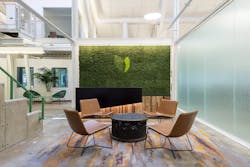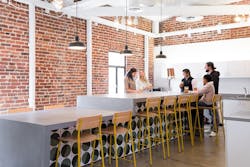Material Health Requires a Look from All Angles
Picture a conference table in any style. Now ask yourself a simple question—how do I know if this furniture is healthy? If this mental exercise feels nebulous, you aren’t alone. One of the ongoing challenges in interior design is to define what a healthy material is.
The leading perspective is that a product should minimize harm to the environment as well as occupants. Read on to learn how your team can start specifying healthy products with more confidence.
[Related: Why This Multifamily Building Pursued Passive House Certification]
The Designer Perspective
Material health is like a multiheaded Hydra—it’s a collection of attributes that can be difficult to pin down. The market is full of product labels, some focused on single attributes while others combine multiple characteristics. Parsing out the most important traits can be a crash course in chemistry, environmental science, manufacturing processes and human biology. Then multiply that detective work across each item designated in a project.
“I did not study climate science as a design student,” joked Ren Decherney, a trained interior designer and business development manager with the International Living Future Institute. “But it’s now our job to weigh this complicated information. A multi-attribute label is a helpful tool because materials need to be socially just and ecologically responsible. You can’t make tradeoffs—they both hold hands together.”
“Be wary of single-attribute claims,” cautioned Anne Karel, senior project manager with IA Interior Architects. “Take the example of an acoustic panel with recycled content. It’s great to have post-consumer material taken out of the waste stream and upcycled. But then what if you learn there’s a risk of that element lowering IAQ? A multi-attribute certification navigates the bigger picture of material health.”
Part of the evaluation process is becoming familiar with a product’s composition. For example, a task chair often contains multiple types of plastics, metals and fabrics. Each component can be vetted for its environmental and human health impacts.
“One place to start is looking at documentation from vendors,” recommended Liz Dalton, an interior designer for the firm Arcsine. “They aren’t always asked, so it may be a backseat in their materials. Those resources are there from manufacturers who have made transparency a priority.”
Tools like the Declare label are another avenue. It does much of the homework for a designer, looking at a product’s life expectancy, embodied carbon, ingredient disclosure and end-of-life options. It also has additional compliance with the Living Building Challenge, which covers responsible sourcing and healthy interior performance. Similar programs include Cradle to Cradle and BIFMA LEVEL.
“My preference is to start with Living Future’s Red List,” Karel explained. “It identifies the top offenders of pervasive, persistent carcinogens—there’s just nothing good about them.”
“The Red List flags chemicals that bioaccumulate in the environment. Furthermore, these compounds are toxic throughout the supply chain, not only to end users but also workers involved in extraction, manufacturing and installation. It’s a worst in class list,” Decherney clarified.
[Related: Meet the Winners of the Inaugural Purpose Awards]
The Client Perspective
The role of healthy materials is also influenced by project goals. An organization’s mission, customers, products, branding and even a founder’s vision can all impact what type of materials will align with a space.
“Different clients have different objectives,” said Karel. “Priorities that affect product selection can look like indoor air quality, recycled content, low VOC, LEED certification, embodied carbon, climate change, social equity and even their own version of a banned list.”
Karel cited healthcare giant Kaiser Permanente as a leading example. Concerned about chemical exposure, the organization prohibits caustic materials such as chemical flame retardants, antimicrobial agents and fluorochemical treatments. Its PVC moratorium not only covers flooring but also wall protection, corner guards, table edging and signage.
The pandemic has also raised the bar on healthy materials to include cleanability and durability. Yet these attributes can create competing objectives, such as wanting the ability to disinfect or sanitize without material degradation. Clients may need guidance on how to balance environmental responsibility, social justice, wellness and product longevity. But in the end, every informed decision is a stride forward.
“I view healthy materials as following the same principles of universal design—making a product better for some people makes it better for all people. Why wouldn’t you specify that option? Plus, there are so many more choices than there used to be,” Dalton said.
“Every little thing a designer does has a huge impact,” emphasized Decherney. “Start with one product on one project. Make the best decisions based on the information you have right now. The impact will be felt not only in your project, but across all the communities that contributed to its creation.”
Brightmark Office Balances Human and Ecological Health
As a waste solutions organization, Brightmark needed a sustainable office that echoed its environmental focus. The process started by selecting a site located in a historic mill rather than building new. With the help of architecture firm Arcsine, the 14,000-square-foot space prioritizes elements that contribute to human and planet wellness, including:
- Living moss walls
- Porcelain manufactured with only water vapor as a byproduct
- Products made by B Corp companies
- Items with Forest Stewardship Council or MAS Certified Green certification (low emissions)
- Reclaimed wood
- Fabrics made from recycled ocean plastics
- Countertops made from 100% recycled paper and repurposed industrial resin
“Brightmark recognized this is an environment where people spend significant time. Products were selected to avoid sick building syndrome, contribute to user wellbeing and honor the planet,” explained Liz Dalton, Arcsine’s lead interior designer for the project.
About the Author:
Jennie Morton has been covering the built environment for the past 11 years.
Read next: Sustainability Plays a Key Role in Emporis Skyscraper Award’s Winning Buildings
About the Author
Jennie Morton
A former BUILDINGS editor, Jennie Morton is a freelance writer specializing in commercial architecture, IoT and proptech.

